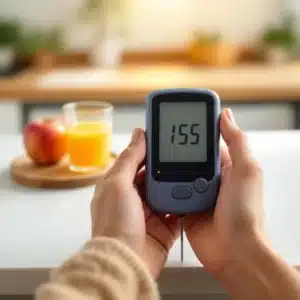When Diabetes Is Dangerous: Critical Warning Signs You Need to Know

What if you could identify the warning signs of diabetes before they escalate into a serious health crisis? Understanding these critical signals could save your life or the life of someone you love.
What is Diabetes?
Diabetes is a chronic condition characterized by the body’s inability to regulate blood sugar (glucose) levels. It occurs when either the pancreas does not produce enough insulin, or the body cannot effectively use the insulin it does produce. Insulin is crucial for converting food into energy and maintaining healthy blood sugar levels.
The Importance of Early Detection
Early detection of diabetes is vital. It allows for timely intervention, which can prevent complications and improve quality of life. Recognizing the warning signs can help individuals take control of their health and seek the necessary medical attention.
Understanding Diabetes
Diabetes is not a one-size-fits-all condition. It can be classified into different types, each with its unique characteristics.
Types of Diabetes: Type 1, Type 2, and Gestational
- Type 1 Diabetes: This is an autoimmune condition where the body attacks the insulin-producing cells in the pancreas. It typically begins in childhood or adolescence, but it can occur at any age.
- Type 2 Diabetes: This is the most common form, often associated with lifestyle factors. In Type 2 diabetes, the body becomes resistant to insulin or does not produce enough of it. It is more prevalent in adults, but it is increasingly seen in children and adolescents.
- Gestational Diabetes: This type occurs during pregnancy. It usually resolves after delivery but increases the risk of developing Type 2 diabetes later in life.
How Diabetes Affects the Body
Diabetes can impact various organs and systems in the body. High blood sugar levels can damage blood vessels, nerves, and organs over time, leading to complications such as cardiovascular disease, kidney damage, and vision loss.
Critical Warning Signs of Diabetes
Being aware of the common symptoms of diabetes is crucial for early detection. Here are some of the key warning signs to watch for:
Common Symptoms
- Increased Thirst and Urination: Frequent urination can lead to dehydration, prompting an increase in thirst. This is often one of the first signs noticed by individuals with diabetes.
- Persistent Hunger: Despite eating, a person with diabetes may feel constantly hungry. This occurs because the body is not effectively using glucose for energy.
- Unexplained Weight Loss: Rapid weight loss without dietary changes can be a sign, especially in Type 1 diabetes, as the body’s cells are not getting the glucose they need.
- Fatigue and Weakness: High blood sugar levels can lead to feelings of extreme tiredness and lack of energy.
- Blurred Vision: Fluctuations in blood sugar levels can cause the lens inside the eye to swell, leading to blurred vision.
- Slow-Healing Wounds: Diabetes affects the body’s ability to heal, so cuts and abrasions may take longer to mend.
- Recurrent Infections: High blood sugar levels can create a breeding ground for bacteria and yeast, increasing the risk of infections.
Less Common Symptoms
In some cases, individuals may experience less common symptoms that can also indicate diabetes:
- Tingling or Numbness in Hands and Feet: This is often a result of nerve damage caused by high blood sugar levels.
- Dark, Velvety Patches on Skin (Acanthosis Nigricans): This is a sign of insulin resistance, frequently seen in Type 2 diabetes.
- Yeast Infections: Recurring yeast infections can be a sign of elevated blood sugar levels.
Emerging Symptoms
Some individuals may experience emerging symptoms that can signal a more severe condition:
- Mood Swings and Irritability: Fluctuating blood sugar levels can affect mood.
- Sleep Issues: Diabetics may experience restlessness or difficulty sleeping, often attributed to high blood sugar levels.
When Diabetes Becomes Dangerous
Diabetes can escalate into life-threatening conditions if left unmanaged. It is crucial to recognize these dangers early:
Diabetic Ketoacidosis (DKA)
DKA is a serious complication that occurs when the body lacks insulin, leading to a buildup of ketones in the blood. Symptoms include:
- Nausea and vomiting
- Abdominal pain
- Fatigue
- Difficulty breathing
Hyperosmolar Hyperglycemic State (HHS)
HHS is a less common but severe condition, primarily affecting those with Type 2 diabetes. It is characterized by dangerously high blood sugar levels. Symptoms include:
- Extreme thirst
- Dry mouth
- Decreased alertness
- Confusion
Long-Term Complications: Kidney Damage, Heart Disease, and Nerve Damage
Chronic high blood sugar levels can lead to complications such as:
- Kidney Damage (Nephropathy): Diabetes is a leading cause of kidney failure.
- Heart Disease and Stroke: Diabetes significantly increases the risk of cardiovascular problems.
- Nerve Damage (Neuropathy): This can lead to pain, numbness, and loss of sensation in the extremities.
Diabetes Management and Prevention
Effective management and prevention strategies are essential for those at risk or diagnosed with diabetes.
Lifestyle Changes for Prevention
- Healthy Diet Tips: A balanced diet rich in fruits, vegetables, whole grains, and lean proteins can help maintain a healthy weight and regulate blood sugar.
- Choose whole foods instead of processed items.
- Limit sugary beverages and foods high in fat and sugar.
- Incorporate fiber into your diet to help slow down digestion.
- Importance of Regular Exercise: Physical activity helps the body use insulin more efficiently and can lower blood sugar levels. Aim for at least 30 minutes of moderate exercise most days.
- Weight Management: Maintaining a healthy weight is crucial, as excess weight can lead to insulin resistance.
Regular Screening and Monitoring
Regular blood sugar checks are vital for those with diabetes. For others, routine screenings can help catch early signs. Consult your healthcare provider to determine the best screening schedule.
Importance of Consulting a Healthcare Provider
Consulting with a healthcare provider is essential for personalized advice and treatment. They can help you understand your risks and recommend appropriate interventions.
Real-Life Stories
Hearing from others who have managed diabetes can be inspiring. Personal stories of triumph over challenges can provide valuable insights and motivation.
Conclusion
Awareness of diabetes warning signs is critical. By recognizing these symptoms early, individuals can take proactive steps to manage their health. If you suspect diabetes, do not delay in seeking medical advice.
Frequently Asked Questions
- What are the main risk factors for diabetes?
- Risk factors include obesity, family history, age, and ethnicity, among others.
- How can I tell the difference between Type 1 and Type 2 diabetes?
- Type 1 is often diagnosed in childhood and requires insulin therapy, while Type 2 is associated with lifestyle factors and can often be managed with diet, exercise, and oral medications.
- What should I do if I suspect I have diabetes?
- Consult your healthcare provider as soon as possible for a proper diagnosis and treatment plan.
- Is diabetes curable, or is it a lifelong condition?
- While Type 1 diabetes is a lifelong condition, Type 2 diabetes can sometimes be reversible through lifestyle changes.
For further reading, please refer to the following scientific


